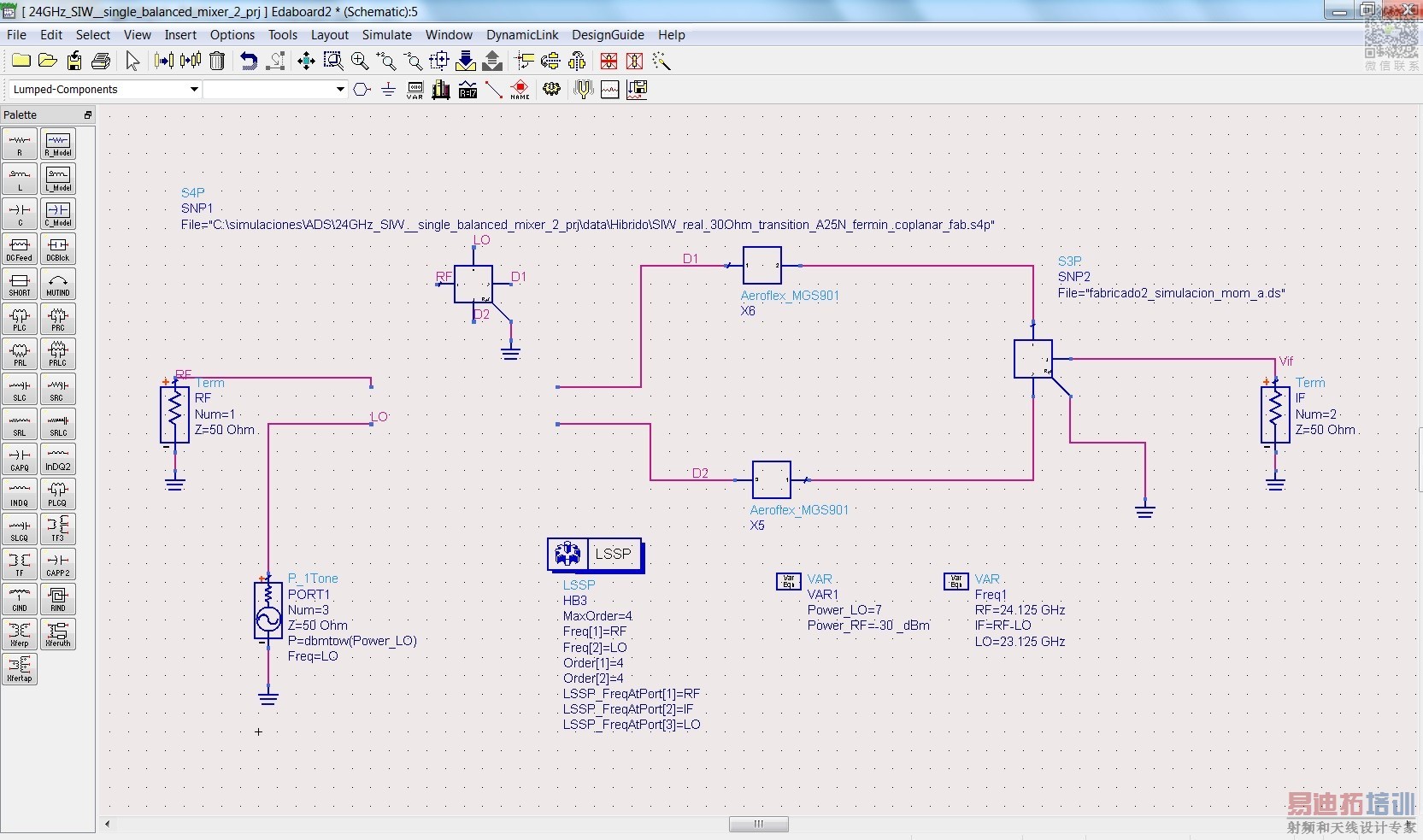- 易迪拓培训,专注于微波、射频、天线设计工程师的培养
Single balanced mixer, shottky pair. Matching problems. LSSP ADS.
I have a simulated design in ADS, but when I look at the matching as a downconverter, using LSSP I've got quite poor results.
Also, the LPF at IF, I desingned it without taking into account the matching at IF port, as I don't know how to simulate the impedance seen.
Mi questions are:
- I post my ADS Schematic. Is the LSSP right configured?
- I'm plotting S(1,1) and S(3,3) to see return Loss at RF and LO. Is this the right way.
- How do you simulate the IF impedance seen at this port to match it to 50 Ohm
Sorry friend. The attached image is just too low-resolution to be able to see much.
I don't use ADS, so I likely would not be able to help much anyway, but I am sure there are lots of folk in the forum who might be able to suggest something if they could read the text in the image. Try for a bigger screen-shot maybe.
As I have seen, you used small signal "signal s-parameter" block for active device. Right ?
If it's so , you have to use "Nonlinear Large Signal Model" for active devices.
I add a bigger schematic, in data items the EM simulation of 180 hybrid and mixer LPF filter.

I have build this mixer and measure it.
Return loss at IF: -5dB at RF=-13dB at LO -8dB, with LO 7dBm.
I'm not able to reproduce this values in simulation. Only LO matching, with the configuration as in the image gives something similar. But I need to be able to simulate RF and IF matching, specially IF matching and impedance to be able to design a better LPF and matching. I don′t understand what BigBoss means with nonlinear large signal model....The diodes model is the manufacturer.
You used small signal s-parameter for mixer (S4P). You cannot do LSSP with small signal models.You have to either use large signal model of the mixer or you should build up this mixer with the same diodes with their large signal models.Otherwise you can not see anything...
OR.. (and this is only a crazy idea!) maybe as a start, he might try temporarily not attempting LSSP, and using the manufacturer provided model slightly modified, at least to explore the matching, and maybe get the lengths and widths right.
The diodes in mixers cannot reasonably live in a linear small-signal model, but he might perhaps mess with the model a little, and remove the "diode" part from the model, leaving only the parasitic capacitances, lead inductances, bulk resistance, etc.
Then - simulate in a normal way. Find out the best lengths and widths to give a good RLR at the ports. Simulating only sections of the network driven at a frequency which assumes the mixer had already successfully mixed might be a fast way to figure out most of the circuit. Using the manufacturer model, removing the diode, and replacing it with a RF source of low impedance. (Telling it lies!)
BigBoss is right in that you cannot do large signal simulation of things that contain non-linear stuff using only linear small-signal models. One thought that does occur is .. if there was a manufacturer-supplied model in the first place, and it was of a mixer, this being a non-linear thing, then what kind S-parameter simulation setup did it ever use, even once, when the model was first thought up and tried?
Is the manufacturer-supplied "model", a sub-circuit type, or a sub-circuit with equation based blocks in it, or is it maybe a big table of S-Parameters?
申明:网友回复良莠不齐,仅供参考。如需专业帮助,请学习易迪拓培训专家讲授的ADS视频培训课程。
上一篇:how to Create your symbol in ADS ?
下一篇:help in using ADS tool in LNA simulation
 国内最全面、最专业的Agilent ADS培训课程,可以帮助您从零开始,全面系统学习ADS设计应用【More..】
国内最全面、最专业的Agilent ADS培训课程,可以帮助您从零开始,全面系统学习ADS设计应用【More..】
- Agilent ADS教学培训课程套装
- 两周学会ADS2011、ADS2013视频教程
- ADS2012、ADS2013射频电路设计详解
- ADS高低阻抗线微带滤波器设计培训教程
- ADS混频器仿真分析实例视频培训课程
- ADS Momentum电磁仿真设计视频课程
- ADS射频电路与通信系统设计高级培训
- ADS Layout和电磁仿真设计培训视频
- ADS Workspace and Simulators Training Course
- ADS Circuit Simulation Training Course
- ADS Layout and EM Simulation Training Course
- Agilent ADS 内部原版培训教材合集
